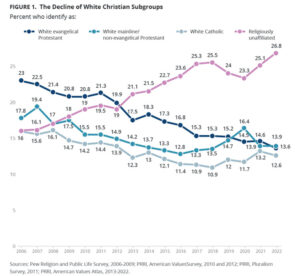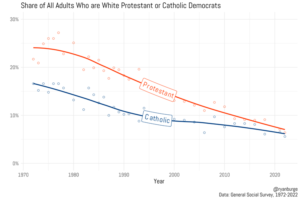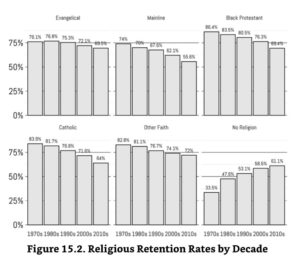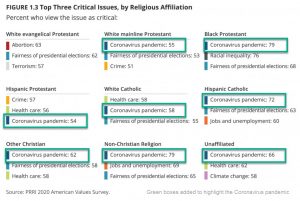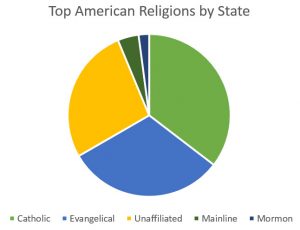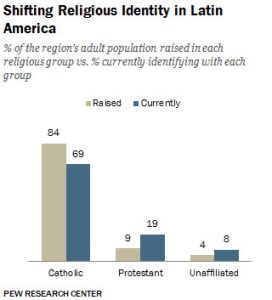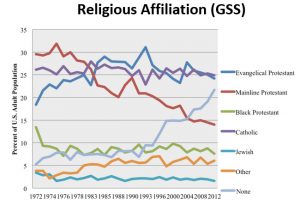When I ask people to guess what percentage of the American population is made up of white Christians, their answers typically range from just over half to nearly the entire population. And, if they were responding decades ago they would have been correct. In reality, less than half of the population belongs to this group today following decades of decline. Recent Decline Public Religion Research Institute (PRRI) published the graphic above in May 2023 illustrating the changes not Read More …
Catholic
Are You Part of an Endangered Species? (#2109)
There are more articles exploring the shift in the American religious landscape over the last 50+ years than I care to attempt to count. For those seeking to lead well and hoping to shape what's yet to come, understanding these changes is essential. Added to Endangered Species List Earlier this month, sociologist Ryan Burge tweeted, "White liberal Christians are an endangered species." In support of that claim he provided the graphic below and the following data points: So Read More …
Lifelong Retention: A Religious Challenge (#1976)
Do you still affiliate with the general religious tradition of your childhood? If so, you are among the majority. In his new book, 20 Myths About Religion and Politics in America (Fortress Press, 2022), Ryan P. Burge includes the myth that the growth of the nones (those with no religious affiliation) is largely from people leaving the church (Myth #15, p.165-174). Using widely available data, Burge shows that the growth of nones is actually due to generational replacement and high retention Read More …
The Critical Issue of COVID-19 (#1898)
The COVID-19 pandemic has changed the way most people live, including the way many worship. COVID-19: USA The number of COVID-19 cases in the United States since the onset of the pandemic now exceeds 10.8 million. And, sadly, nearly a quarter of a million of these individuals (245,000 as of November 15, 2020) have died. The spread of COVID-19 is accelerating nationwide. The dramatic growth in new cases is shown below using a screenshot of data provided by the New York Read More …
Consistently Progressive Christians Outnumber Consistently Conservative Christians (#1891)
Guthrie Graves-Fitzsimmons devotes an entire chapter in his timely new book - Just Faith: Reclaiming Progressive Christianity (Broadleaf Books, 2020) - to explaining that consistently progressive or liberal Christian adults in the United States outnumber consistently conservative Christian adults by a margin of almost two to one. Graves-Fitzsimmons relies on research conducted by the Public Religion Research Institute in 2018 for his Read More …
Americans Feel More Positive About Most Religions (#1670)
According to research conducted by the Pew Research Center, between June 2014 and January 2017, American views shifted to become more positive about about most of the world's great religions. More specifically, survey respondents were asked to to rate a variety of groups on a “feeling thermometer” that ranged from 0 to 100 (with higher numbers reflecting warmer or more positive feelings). Respondents warmed to several religions during this two and a half year period, including Read More …
Top Religions by State (#1606)
There are many ways to look at America's top religions. The Public Religion Research Institute's new American Values Atlas offers a helpful way to consider the religious makeup of the United States on both a national and state level. National Perspective As a whole the top three religions in our country are Catholic - 22% Religiously unaffiliated - 22% White Evangelical Protestants - 18%. Personal Experience I have spent my life in Texas and Florida. The largest Read More …
Fewer and Fewer Christians (& Even Fewer Mainline Protestants) (#1551)
In 2007 the Pew Research Center conducted their initial U.S. Religious Landscape Study. The 2014 edition, published earlier today, shows Christianity declined by 8% in America over the last seven years (78.4% to 70.6%). Allowing for the margin of error, this means the number of Christian adults in the U.S. has shrunk by somewhere between 2.8 million and 7.8 million. Decline Impacts All Christian Traditions Mainline Protestants and Catholics top the list for Read More …
Changes in Christian Affiliation in Latin America (#1492)
Last week the Pew Research Center released findings from their recent survey examining religious affiliations, beliefs and practices in 18 countries and one U.S. territory (Puerto Rico) across Latin America and the Caribbean. While this region of the world is home to over 400 million Catholics (nearly 40% of the global total) and despite the popularity of the first Latin American Pope, affiliation with Catholicism is declining rapidly. Dramatic Decline From the 1900s through the Read More …
Shifts in Religious Affiliation (1972-2012) (#1464)
The changing role of religion in American culture is a popular topic of conversation among religious leaders. Those leaders situated within Mainline Protestantism (a tradition I claim as my own) are talking more openly than ever before about decline. Even the names used to describe the tradition increasingly recognize that the decline is both about diminishing numbers of adherents (Oldline) and a more marginalized role (Sideline). While I am encouraged by increased attention Read More …
